Every year, the introduction of harmful, non-native species into the U.S. has been increasing. Collectively, these nuisance species make tremendous impacts to different things valued by many Americans. Ultimately, the cost of invasive species (terrestrial and aquatic) in the United States amounts to more than $100 billion each year. Go to the Hitchhiker section to learn more about each species and their individual impacts. Click on the sections below for details on the negative impacts of harmful invaders.
One of the most significant impacts of Aquatic Hitchhikers is on game fish populations. Game fish have been impacted in numerous ways.
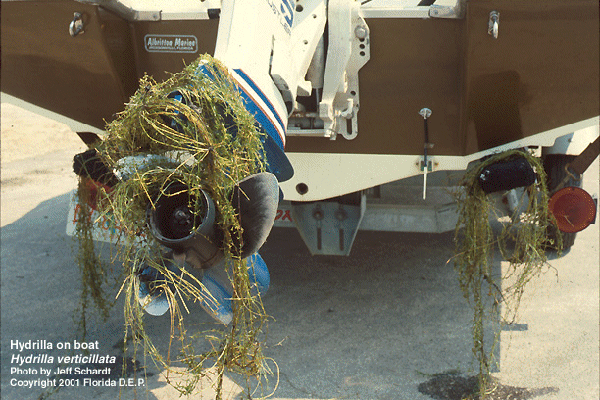
Another significant impact of Aquatic Hitchhikers is the effect on recreational boats. Non-native plants such as hydrilla and water hyacinth can clog water intakes on motors and thereby overheat and ruin your engine. Zebra mussels can also clog water intakes and have the potential to attach themselves to the prop and all areas of the motor, thereby either affecting the performance of the engine and or actually jamming steering equipment.
Some harmful, non-native species, particularly plants like hydrilla and water hyacinth are so detrimental that they completely cover the waters they invade. Waters become so choked with these non-native plants that it is practically impossible to get a boat through and there is no open water left for swimmers to enjoy. Other nuisance species such as zebra mussels leave sharp-edged shells along swimming beaches which can be a hazard to unprotected feet.
Industrial water users and businesses such as public utilities, power plants, municipal drinking water facilities and manufacturing industries all need a constant supply of water. However, with the proliferation of these harmful, non-native species like zebra mussels, many industries have had to develop costly control methods to maintain their water intake systems. The costs incurred from these control methods are eventually passed onto consumers, like you and me.
The Great Lakes provides a good example of the extent of aquatic nuisance species impacts. Water users in the region spend tens of millions of dollars on zebra mussel control every year. The zebra mussel attaches to hard surfaces and colonize on structures like those used for power and municipal water treatment plants. These industrial plants have reported significant reductions in pumping capabilities and occasional shutdowns.
Here are some figures that underscore these impacts.
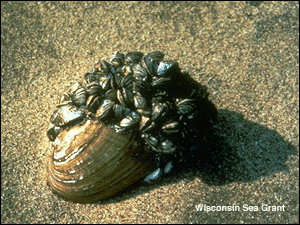
The bottom line is that as zebra mussels and other aquatic hitchhikers spread to inland lakes and rivers across North America, like the Mississippi River Basin and Lake Champlain, so do the costs to water users.
Invasive species impact nearly half of the species currently listed as Threatened or Endangered under the U.S. Federal Endangered Species Act. The section above on game fish covers how the native fish species are affected, but native plants and wildlife that live around the waters are also affected.
Harmful, non-native aquatic plants such as purple loosestrife, Eurasian watermilfoil and hydrilla quickly establish themselves replacing native plants. In addition to diminishing our nation’s biological diversity by eliminating native species, the plants cause other serious environmental and economic problems.
In our natural world, everything is connected to everything else. When one aspect of an ecosystem is affected, it creates a domino affect resulting in many unforeseen changes. Zebra mussels provide a good example of how aquatic hitchhikers can cause pronounced ecological changes. In the Great Lakes, the zebra mussel’s rapid reproduction, coupled with its consumption of microscopic plants and animals, has affected the fragility of this system’s entire aquatic food web
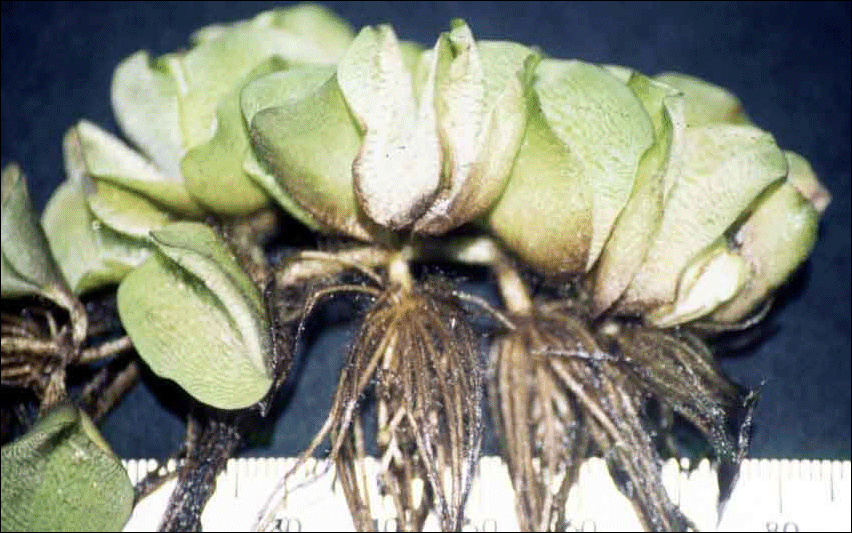
The impacts of rusty crayfish are another good example. They reduce aquatic plant abundance and species diversity. Submerged native aquatic plants are important habitat for invertebrates (which provide food for fish and ducks), shelter for young game fish or forage species of fish, and nesting areas for fish. Also once native vegetation disappears, erosion can take place (plants minimize impact of waves) further adding to the degradation of an ecosystem.
Nuisance plant invasions trigger several domino affects. Water hyacinth is an example of a nuisance plant that degrades water quality by blocking photosynthesis, which greatly reduces oxygen levels in the water. This creates a cascading effect by reducing other underwater life such as fish and other plants. Water hyacinth also reduces biological diversity, impacts native submersed plants, alter immersed plant communities by pushing away and crushing them, and also alter animal communities by blocking access to the water and/or eliminating plants the animals depend on for shelter and nesting.
Another nuisance plant, purple loosestrife has taken over numerous wetlands. This harmful non-native plant has crowded out native vegetation and has impacted migratory birds. As a result waterfowl hunting and bird watching opportunities have diminished in areas affected by this plant.
The common carp is an example of a nuisance fish that has made a significant impact. It feeds by browsing on submerged vegetation – uprooting plants on which ducks feed, muddying the waters and destroying food and cover needed by other fish.
As significant filter feeders, zebra mussels may increase human and wildlife exposure to organic pollutants such as PCB’s and PAHs. Early research shows that zebra mussels can rapidly accumulate organic pollutants within their tissues to levels more than 300,000 times greater than concentrations in the environment. They also deposit these pollutants in their pseudofeces. These contaminants can be passed up the food chain so that any fish or waterfowl consuming zebra mussels will also accumulate these organic pollutants. Likewise, human consumption of these same fish and waterfowl could result in further risk of exposure.
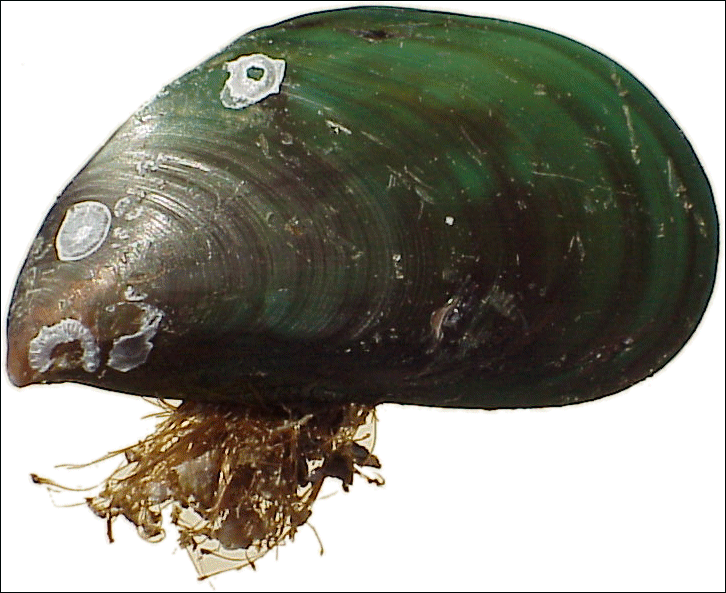
Other ANS invasions have been shown to pose additional health risks. A South American strain of human cholera bacteria was found in ballast tanks in the port of Mobile, Alabama in 1991. Cholera strains were also found in oyster and fin-fish samples in Mobile Bay, resulting in a public health advisory to avoid handling or eating raw oysters or seafood.
Homes or lots adjacent to a quality water body (stream, lake, and coastal area) are valued substantially higher than those even a block away from the water. However, these waterfront values can quickly decline due to water quality problems. For example, in a community in Pennsylvania, two lakes set side by side, separated only by a small land mass. However, one lake is not able to support fish. The property value of homes on the fishless lake is lower than homes located a block away on the quality fishing lake. When lakes are choked with weeds where no recreation can occur, the property value is further reduced.
Our country’s economy is intimately linked to the health of our aquatic resources. The outdoor recreation industry derives significant benefits from dynamic aquatic systems, particularly mom-and-pop operations. However, this is only one of the many sectors that rely on the health of our waters for their economic viability. Throughout the country, coastal towns and cities have developed along our large river systems, the Great Lakes and the shores of the Gulf, the Atlantic and the Pacific. Collectively, these waters create a vast transportation network that facilitates commerce and ultimately provide the economic life blood that supports water-dependent communities.
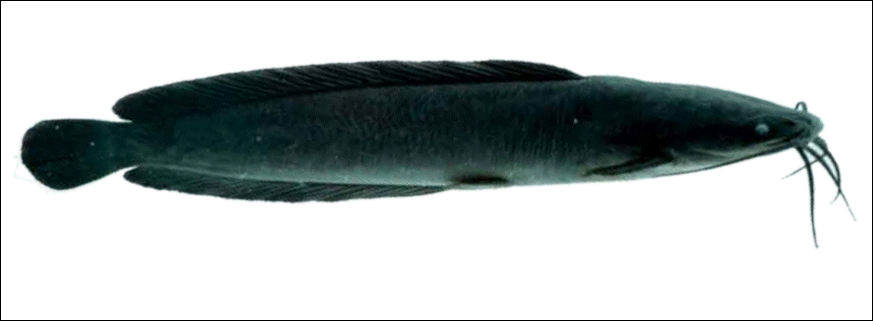
So, when hitchhikers like the sea lamprey, ruffe or round goby enter into the waters where these coastal gateway communities are situated, much is at stake. Jobs and dollars are only the tip of the iceberg. In addition to the potential for significant, long-term ecological harm, lifestyles and entire family generations can be impacted by harmful, non-native species.